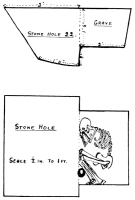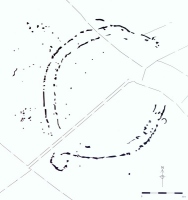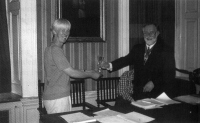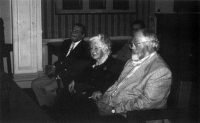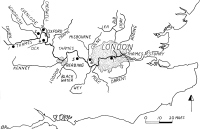|
|
|
|
Deeds of Covenant Unpaid Subscriptions The Society's Jewellery Collection A First Enclosure for Leicestershire Editorial News Hoards, Landscapes and Horses for Courses 'Le Petit Sorcier À L'Arc Musical': A Reply Editor's Notes on Le 'Sorcier' The Prehistoric Settlement of the Thames Valley (1) The Prehistoric Settlement of the Thames Valley (2) Research Frameworks for the Palaeolithic and Mesolithic Britain and Ireland Champion's Choice Conferences
|
|
|
|
|
|
THE SOCIETY'S JEWELLERY COLLECTION
|
|
A
FIRST CAUSEWAYED ENCLOSURE FOR LEICESTERSHIRE
|
|
|
There are very few neolithic monuments known from Leicestershire and until recently there were no known causewayed enclosures. One has now been identified following gradiometer survey by University of Leicester Archaeological Services (ULAS), directed by Adrian Butler; targeting a flint scatter at Husbands Bosworth (SK 635 825) in the south of the county. Situated on a sand and gravel spur overlooking a small valley, the monument consists of a closely-grouped concentric circuit consisting of a double ring of interrupted ditches enclosing an ovoid area covering c. 1.5 ha. The spacing between the two ditches averaged nine metres, falling into Palmer's 'narrow' category (Palmer 1976 Type 3) and its form has affinities with other examples from Barholm in Lincolnshire and Briar Hill in Northamptonshire (Palmer 1976 p.184 figs 14-15; Bamford 1985).
Subsequent trial trenching by ULAS, directed by John Thomas, confirmed the presence of an interrupted ditch system, the upper levels of which contained late neolithic pottery, including impressed wares, and flint. No banks had survived as surface features, although possible evidence for an internal bank may be inferred from a thick stony layer which had slumped in from the interior of the site. A small concentration of post holes between the two ditches may have served as timber revetment to a bank to ensure stability. | |
|
The discovery adds to the growing evidence for neolithic occupation in this area of the East Midlands. Located between the watersheds of the Rivers Avon, Soar, Welland and Swift, all valleys where neolithic material has been found previously, the monument may have been located at the interface of different territories.
|
|
|
|
|
|
|
|
The Society's Annual General Meeting is a mixture of business and pleasure, with the formal business of receiving the accounts and election of Officers and new Council Members taking only a few minutes. The pleasure is in the announcement of Awards, namely the Baguley Award for the best paper in the Proceedings, the Research Grant Awards for the forthcoming year (including the Bob Smith Award and the Leslie Grinsell Award) and the John and Bryony Coles Award which provides funds for students to travel as part of their research or undergraduate studies. The Europa lecture is then given by the winner of the Europa Prize (set up by Professor Sir Grahame Clark for scholars who have distinguished themselves in the field of European prehistory). The evening ends with a wine reception so that the speaker can answer questions in a relaxing atmosphere.
|
|
|
At the 1999 AGM Professor Bryony Coles was awarded the R. M. Baguley Award for her paper "Doggerland: A Speculative Survey" in the 1998 Proceedings. The Europa Prize was awarded to Dr Evzen Neustupný, who gave a lecture on "The Earliest Megalithic Tombs in Bohemia and Moravia"
|
|
|
HOARDS,
LANDSCAPES AND HORSES FOR COURSES
|
|
"LE
PETIT SORCIER A L'ARC MUSICAL": A REPLY
|
|||
|
| |
| (a) |
I have carried out some net-based bibliographical research on the Begouën reference referred to, but not located, by Demouche, Slimak, and Deflandre above and by Eastham in his original piece. I was unable to locate a 1927 publication entitled The Clay Bison: however, it would appear that one English-language version of the book referred to by Michael Eastham was called Bison of Clay, published (in a translation by R. L. Duffus) by Longmans, Green & Co (New York) in 1926. Trinity College Dublin library catalogue shows a book under the same title, but published in London (no publisher recorded) in 1926. This/these must surely be a translation of Begouën's Les bisons d'argile, published in Paris in 1925 by A. Fayard and listed in the catalogue of the Bibliotheque Nationale de France and in other university libraries searchable on the Net. As I have seen neither the original or the translation, I am unable to verify whether the Begouën reference to a quadripedal stance occurs in this text; but we should remember that Eastham was referring to Begouën's comment on the "large 'Sorcerer'" in his PAST piece, rather than the Petit Sorcier; and was not absolutely certain ("if I remember rightly") that Begouën had said it in print. Any further information from readers who have access to the original French text or any of the English versions referred to above would be of interest to our French colleagues (and to your editor). |
| (b) |
The figure has also been interpreted as dancing: "...man wears the horned mask of a bison from which the skin hangs with the tail swinging to the rhythm of the dance" (Clark & Piggott 1970, 84 and fig, 27); perhaps a bipedal 'dancing' posture is also consonant with the extended foot referred to by our French colleagues above.
|
|
References Clark, G & Piggott, S 1970 Prehistoric Societies. London: Penguin
|
|
|
THE
PREHISTORIC SETTLEMENT OF THE THAMES VALLEY (1)
|
|
THE
PREHISTORIC SETTLEMENT OF THE THAMES VALLEY (2)
|
|
|
Some Londoners consider that the Thames is actually 'their' river as it flows through the heart of the metropolis. However; it should be remembered that the Thames flows across some 210 miles (338 km) of southern England and the lowest 65 miles (105 km) of the river is tidal estuary. The Thames rises in the Gloucestershire Cotswolds, then flows south-eastwards across Oxfordshire; as it gains in volume it demarcates parts of the county boundaries of Berkshire, Buckinghamshire and Surrey before arriving in Greater London. The Thames and its tributaries, which include the Cherwell, Colne, Lea, Kennet, Roding and Thame drain a vast area of Southern England. The power of this river system is demonstrated by the broad valley it has created - now lined with gravel terraces, relics of the changing river levels during the Pleistocene.
The Thames is the oldest documented English river-name. In 51BC Caesar wrote an account of his second invasion of Britain in 54BC in which he described it as the Thamesis, probably Celtic for dark or silt laden river (Ekwall 1928, 402). Caesar noted the Thames served as the boundary between the territory of Cassivellaunus and the 'maritime tribes' in Kent (Handford 1951, 135), which is a reminder that navigable rivers are both routeways and also serve as boundaries. The Prehistoric Society conference considered the broader research implications of the vast amount of recent archaeological work along the entire Thames Valley, the programme being divided into four period-based sessions.
|
|
|
Mesolithic/early neolithic
During the mesolithic period the environs of the Thames and its tributaries were widely utilised by highly mobile hunters and gatherers taking advantage of the rich fishing and wild fowling. Evidence of transient mesolithic occupation is provided by scatters of flint knapping debris found along the riverside. Within an infilled mesolithic palaeochannel of the Thames at Eton traces of beaver dams or lodges have been found. Excavations at the site of the new rowing lake at Eton in Buckinghamshire have demonstrated that during the early neolithic the tradition of riverside flint knapping continued and there was also evidence of woodland clearance by burning, probably to provide pasture. The impression is that during the early neolithic the upper Thames at Eton was utilised by pastoralists, who camped here on a seasonal basis and deposited their rubbish within natural hollows. Food residues on pottery from these hollows show traces of dairy products (Ken Welsh, Oxford Arch. Unit, 'Discoveries in the prehistoric River Thames at the Eton rowing lake, Bucks'). A different pattern of neolithic activity has been revealed by excavations on the gravel terraces of the upper Thames at Yarnton in Oxfordshire. Here a rectangular, ditched mortuary enclosure was constructed, a rectangular hall or communal 'long house' (some 20 m long and 10m wide) defined by postholes, plus numerous pits and miscellaneous postholes (Gill Hey, Oxford Arch. Unit, 'Life on the flood-plain: Yarnton in the fourth and third millennia BC'). The impression is that Yarnton was an area of open grassland (not arable), which was not continuously occupied, but was inhabited on an intermittent or seasonal basis for a long period of time by pastoralists. The animal bone assemblage is dominated by cattle, sheep/goat and pig. The presence of charred grain and bread demonstrates that cereals were produced nearby. The excavations at both Eton and Yarnton suggest that during the early neolithic the banks of the upper Thames were utilised by small, mobile communities of pastoralists, perhaps practising transhumance and possibly carrying out shifting cultivation on the higher gravel terraces within the Thames Valley, to produce cereal crops. During this period it is clear that the upper Thames had no fixed course, as at both Eton and Yarnton there is evidence of eyots (small islands) created by braided channels or meanders, which periodically silted up when the course of the river moved.
|
|
|
RESEARCH
FRAMEWORKS FOR THE PALAEOLITHIC AND MESOLITHIC OF BRITAIN AND IRELAND
|
|
CHAMPION'S
CHOICE
|
|||||||||||
|
SCRAN: Funded by the Millennium Commission, the Scottish Cultural
Resources Access Network's mission is "to create a fully searchable
resource base of Scottish material culture and human history". Not concerned
solely with prehistory, this fully searchable database comprises many
thousands of records of sites, monuments and artefacts, including those
of the NMRS and Historic Scotland as well as other web-based resources.
Feed in a search term (eg henge) and click on individual listings for
details, and images where a camera icon is displayed.
| |||||||||||
|
|
|||||||||||
|
3rd Congress on Iberian Archaeology: 22.9.99-26.9.99
|
|||||||||||
 |
The Prehistoric Society Home Page |
